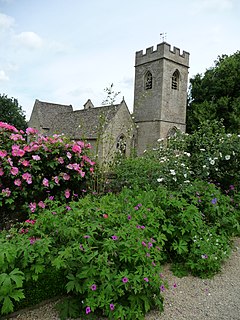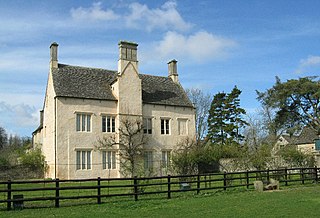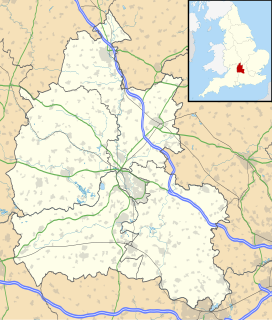
Minster Lovell Hall is a ruin in Minster Lovell, an English village in the Oxfordshire Cotswolds. The ruins are situated by the River Windrush.

Minster Lovell Hall is a ruin in Minster Lovell, an English village in the Oxfordshire Cotswolds. The ruins are situated by the River Windrush.

Minster Lovell Hall was built by William Lovell around 1440. [1] As Minster Lovell was one of the earliest estates held by the Lovell family and one of their main residences it was at least the second building occupying this site. [2]
The Hall was a fairly typical if impressive manor house. The buildings surround three sides of a square; the fourth side towards the River Windrush was closed off by a wall. The great tower at the south-west corner seems to be a later addition to the house, as part of the adjoining west wing had to be rebuilt. [3]
Minster Lovell Hall remained the main residence of the Lovell family. Richard III visited it as a guest of Francis Lovell, 1st Viscount Lovell, grandson of William Lovell. [4] Francis Lovell's estates were declared forfeit after the Battle of Bosworth and Minster Lovell was granted to Jasper Tudor, uncle of Henry VII. [5]
The property changed hands several times over the next two centuries. [6] Among the owners were Henry VIII's gentlemen of the stool, William Compton and Henry Norris. [7]
The property was bought in 1603 by Sir Edward Coke. The manor remained in the Coke family for several generations, and Thomas Coke, created Baron Lovel in 1728, abandoned Minster Lovell Hall in 1747. [8] Large parts of the buildings were dismantled. [9] By the early nineteenth century the ruins of Minster Lovell Hall were thought to have been the buildings of an alien priory. [10]
According to one report a skeleton was discovered in the basement of Minster Lovell Hall in 1718 and was thought to be that of Francis Lovell who had hidden there after the Battle of Stoke and had died of starvation. [11] Unfortunately, it seems unlikely this is the case. Francis Lovell spent little time in Minster Lovell and therefore would have no faithful servant there who could hide and feed him for years.
The quite extensive ruins of Minster Lovell Hall are now in the care of English Heritage as a Grade I listed building [12] and scheduled monument. [13] The most prominent features are the Hall with its ornamented entrance porch and the south west tower. A dovecote, probably also built in the fifteenth century, is also part of the site. [12] Much of the site has fallen over the years but large amounts remain to this day.

Oxfordshire is a landlocked county in the far west of the government statistical region of South East England. The ceremonial county borders Warwickshire to the north-west, Northamptonshire to the north-east, Buckinghamshire to the east, Berkshire to the south, Wiltshire to the south-west and Gloucestershire to the west.

Francis Lovell, 9th Baron Lovell, 6th Baron Holand, later 1st Viscount Lovell KG was an English nobleman who was an ally of King Richard III during the War of the Roses. Sir William Catesby, Sir Richard Ratcliffe and he were among Richard's closest supporters, famously called "the Cat, the Rat and Lovell our dog" in an anti-Ricardian squib. In addition to being an ally, Lovell is attributed as Richard's best friend.

The county of Oxfordshire in England was formed in the early years of the 10th century and is broadly situated in the land between the River Thames to the south, the Cotswolds to the west, the Chilterns to the east and The Midlands to the north, with spurs running south to Henley-on-Thames and north to Banbury.

Thomas Coke, 1st Earl of Leicester, KB was an English land-owner and patron of the arts. He is particularly noted for commissioning the design and construction of Holkham Hall in north Norfolk. Between 1722 and 1728, he was one of the two Members of Parliament for Norfolk. He was honoured by being created first Earl of Leicester, in a recreation of an ancient earldom.
Elsyng Palace was a Tudor palace on the site of what are now the grounds of Forty Hall in Enfield, north London. Its exact location was lost for many years until excavations were carried out in the 1960s.

Asthall or Asthal is a village and civil parish on the River Windrush in Oxfordshire, about 6 miles (10 km) west of Witney. It includes the hamlets of Asthall Leigh, Field Assarts, Stonelands, Worsham and part of Fordwells. The 2011 Census recorded the parish's population as 252. Asthall village is just south of the River Windrush, which also forms the south-eastern part of its boundary. The remainder of the parish including all of its hamlets lie north of the river. A minor road through Fordwells forms most of the parish's northern boundary. Most of the remainder of the parish's boundary is formed by field boundaries.
Henry Norris was an English courtier who was Groom of the Stool in the privy chamber of King Henry VIII. While a close servant of the King, he also supported the faction in court led by Queen Anne Boleyn, and when Anne fell out of favour, he was among those accused of treason and adultery with her. He was found guilty and executed, together with the Queen's brother, George Boleyn, Sir Francis Weston, William Brereton and Mark Smeaton. Most historical authorities argue that the accusations were untrue and part of a plot to get rid of Anne.

Standlake is a village and civil parish in West Oxfordshire about 5 miles (8 km) southeast of Witney and 7 miles (11 km) west of Oxford, England. The parish includes the hamlet of Brighthampton. The 2011 Census recorded the parish's population as 1,497. The River Windrush flows past the village and with its tributary Medley Brook it forms much of the eastern boundary of the parish. The western boundary has been subject to changes and disputes in past centuries. It now follows Brighthampton Cut, an artificial land drain dug in the 19th century. The Windrush joins the River Thames at Newbridge just over 1 mile (1.6 km) to the south.

Guiting Power is a village and civil parish in the Cotswolds, in Gloucestershire, England. The population of the parish at the 2011 census was 296.

Weeting Castle is a ruined, medieval manor house near the village of Weeting in Norfolk, England. It was built around 1180 by Hugh de Plais, and comprised a three-storey tower, a substantial hall, and a service block, with a separate kitchen positioned near the house. A moat was later dug around the site in the 13th century. The house was not fortified, although it drew on architectural features typically found in castles of the period, and instead formed a very large, high-status domestic dwelling. It was probably intended to resemble the hall at Castle Acre Castle, owned by Hugh's feudal lord, Hamelin de Warenne.

Cogges Manor Farm is a one-time working farm in Cogges near Witney in Oxfordshire, England, now a heritage centre operated by a charitable trust and open to the public.

Cogges is an area beside the River Windrush in Witney, Oxfordshire, 0.5 miles (800 m) east of the town centre. It had been a separate village and until 1932 it was a separate civil parish.

Minster Lovell is a village and civil parish on the River Windrush about 2+1⁄2 miles (4 km) west of Witney in Oxfordshire. The 2011 Census recorded the parish's population as 1,409. Minster Lovell village has three parts: Old Minster, Little Minster and New Minster. Old Minster includes the parish church, Minster Lovell Hall and the Old Swan Inn and Minster Mill Hotel. A large part of New Minster is the Charterville Allotments, which were founded by the Chartists in 1846–50.

Beckett Hall is a country house at Shrivenham in the English county of Oxfordshire. The present house dates from 1831.

Asthall Manor is a gabled Jacobean Cotswold manor house in Asthall, Oxfordshire. It was built in about 1620 and altered and enlarged in about 1916. The house is Grade II listed on the National Heritage List for England.

Somerton is a village and civil parish in Oxfordshire, England, in the Cherwell valley about 6 miles (10 km) northwest of Bicester. The 2011 Census recorded the parish's population as 305.

Great Tew is an English village and civil parish in the Cotswold Hills in Oxfordshire, about 5 miles (8 km) north-east of Chipping Norton and 8 miles (13 km) south-west of Banbury. The 2011 Census gave a parish population of 156. This qualifies it only for an annual parish meeting, not a monthly parish council. The village has largely belonged since the 1960s to the Johnston family, as the Great Tew Estate, with ongoing renovations and improvements. A news report in 2020 stated that David Beckham and Victoria Beckham owned a "£6m Great Tew country home", Maplewood Barn, formerly Park Barn. Great Tew had 87 Grade II listed buildings in 2021.

Sydenham is a village and civil parish about 3 miles (5 km) southeast of Thame in Oxfordshire. To the south the parish is bounded by the ancient Lower Icknield Way, and on its other sides largely by brooks that merge as Cuttle Brook, a tributary of the River Thame. The 2011 Census recorded the parish's population as 451.

Taynton is a village and civil parish about 1+1⁄2 miles (2.4 km) northwest of Burford in West Oxfordshire. The village is on Coombe Brook, a tributary of the River Windrush. The parish is bounded in the south by the River Windrush, in the north partly by Coombe Brook and its tributary Hazelden Brook, in the west by the county boundary with Gloucestershire and in the east by field boundaries. The 2001 Census recorded the parish's population as 108.
There have been four baronies and one viscountcy created in the name of Lovel or Lovell.
| Wikimedia Commons has media related to Minster Lovell Hall . |
Coordinates: 51°47′59″N1°31′51″W / 51.799681°N 1.5308589°W